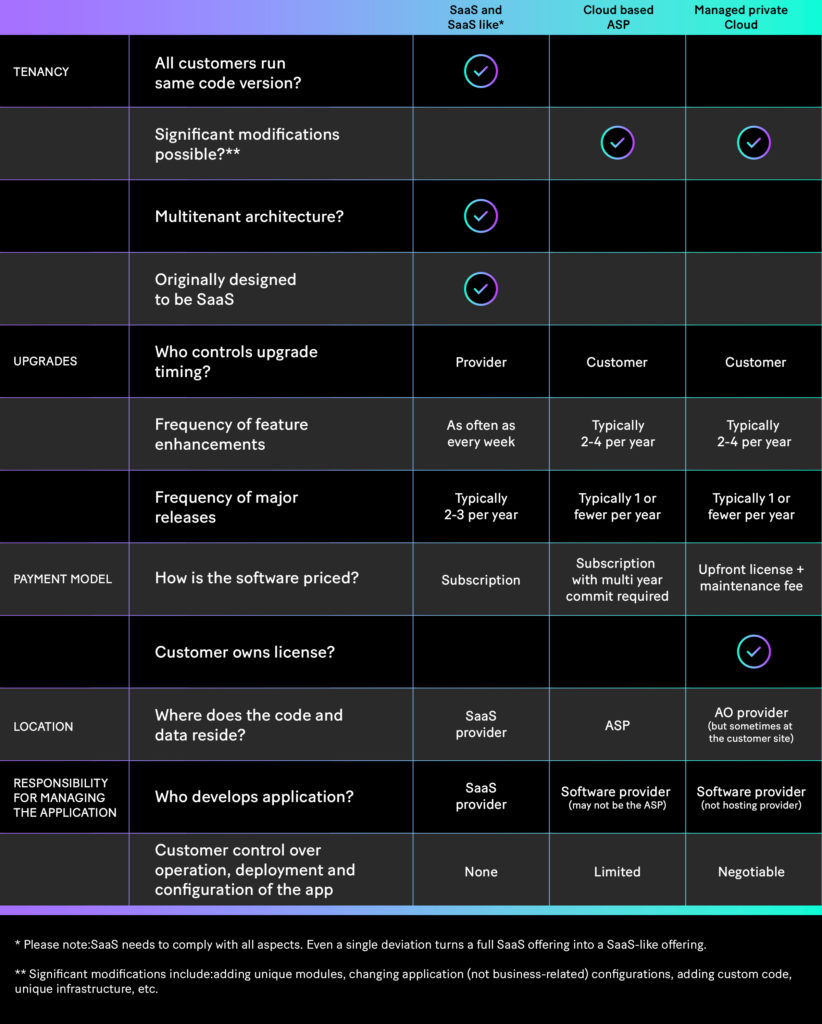Amid the modern world’s constant heady rush of technology, it’s easy to get confused. There’s always a new acronym to get to grips with; and solutions that on the face of things appear quite similar are, when you get into the details, entirely different beasts.
Take Software-as-a-Service (SaaS), Application Service Providers (ASP) and managed private cloud services, for example. They’re all third-party solutions to a business’s software needs, in which most, or all, of what allows the system to function is hosted off-premises with the third-party company. But that’s where the similarities stop, with each solution boasting its own unique set of advantages and disadvantages, which need considering in regard to the client (or tenant) business’s requirements.
SaaS is easily the most dynamic of the three and accessible to even fledgling companies without large budgets. It offers a single software solution that multiple organizations (known as tenants) can subscribe to and is, in almost all cases, hosted in the cloud, typically using a public cloud provider. Access is generally through the use of nothing but a “thin client,” i.e. a web browser, requiring no major downloads or infrastructure at the consumer’s end.
Examples of SaaS firms
- Salesforce
- ServiceNow
- Atlassian
- HubSpot
Economies of scale pave the way to major savings for their clients, both regarding development and maintenance, all of which is performed by the SaaS companies themselves, with no need for the consuming organization to employ any on-site IT technicians.
Furthermore, there is no expectation for consumers to make long-term commitments. Subscriptions can be purchased and dropped with relative ease, even allowing room to trial SaaS solutions.
Counter to this, SaaS is not bespoke to any particular company’s needs, other than perhaps some minor user-level configuration, with the SaaS provider being in charge of the timing and direction of any upgrades. Though again, economies of scale mean that the enhancements that do occur are frequent, adapting to a broad, fast-changing market and can come to cover multiple aspects of what the SaaS provides.
Seeing the difference

ASP, meanwhile, provides a more tailored service. The software package is developed and hosted by the vendor, retaining the benefit for the consuming organization of not needing to manage their server and technical infrastructure. ASP solutions can, however, be aligned directly to the client’s business needs as they typically have a unique version of the software solution for themselves. Depending on the software, ASP solutions may still only require the consuming organization to need a web browser; however, some may require the installation of a desktop client.
Much like SaaS, the ASP provider will host the ASP application in some form of cloud. This can vary between a private cloud and the use of a public cloud provider.
The clear advantage of ASP is that it puts the client in the driving seat of the solution, generally controlling both the timing of and direction of software upgrades. These can be significant and more precisely geared toward the needs of their business. This all comes at a cost, however, meaning upgrades tend to happen less frequently, while a subscription to ASP often necessitates a multi-year commitment.
Managed private cloud services offer a step further down the bespoke route. They are still developed by third-party companies, but the customer goes on to own the licence of the service and has even more control over how it might be developed and updated in the future. Unsurprisingly, they are more expensive still, as the more bespoke the service is, the more its maintenance costs, not to mention that an upfront licence fee must be paid.
In choosing a solution, businesses should consider how much control they need to have and weigh that up against the cost and flexibility. SaaS provides the best cost and arguably flexibility, while ASP may strike the best balance of cost VS control.